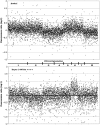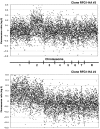Widespread occurrence of chromosomal aneuploidy following the routine production of Candida albicans mutants
- PMID: 19732157
- PMCID: PMC2784216
- DOI: 10.1111/j.1567-1364.2009.00563.x
Widespread occurrence of chromosomal aneuploidy following the routine production of Candida albicans mutants
Abstract
It has come to our attention that approximately 35% of >100 published microarray datasets, where transcript levels were compared between two different strains, exhibit some form of chromosome-specific bias. While some of these arose from the use of strains whose aneuploidies were not known at the time, in a worrisome number of cases the recombinant strains have acquired additional aneuploidies that were not initially present in the parental strain. The aneuploidies often affected a different chromosome than the one harboring the insertion site. The affected strains originated from either CAI-4, RM1000, BWP17 or SN95 and were produced through a variety of strategies. These observations suggest that aneuploidies frequently occur during the production of recombinant strains and have an effect on global transcript profiles outside of the afflicted chromosome(s), thus raising the possibility of unintended phenotypic consequences. Thus, we propose that all Candida albicans mutants and strains should be tested for aneuploidy before being used in further studies. To this end, we describe a new rapid testing method, based on a multiplex quantitative PCR assay, that produces eight bands of distinct sizes from either the left or right arms of each C. albicans chromosome.
Figures




Similar articles
-
Comparative genome hybridization reveals widespread aneuploidy in Candida albicans laboratory strains.Mol Microbiol. 2005 Mar;55(5):1553-65. doi: 10.1111/j.1365-2958.2005.04492.x. Mol Microbiol. 2005. PMID: 15720560
-
Transcriptional Regulation on Aneuploid Chromosomes in Divers Candida albicans Mutants.Sci Rep. 2018 Jan 26;8(1):1630. doi: 10.1038/s41598-018-20106-9. Sci Rep. 2018. PMID: 29374238 Free PMC article.
-
Aneuploidy enables adaptation to brefeldin A in Candida albicans.Front Cell Infect Microbiol. 2025 Apr 28;15:1562726. doi: 10.3389/fcimb.2025.1562726. eCollection 2025. Front Cell Infect Microbiol. 2025. PMID: 40357392 Free PMC article.
-
Use of a DNA method, QF-PCR, in the prenatal diagnosis of fetal aneuploidies.J Obstet Gynaecol Can. 2011 Sep;33(9):955-960. doi: 10.1016/S1701-2163(16)35022-8. J Obstet Gynaecol Can. 2011. PMID: 21923994 Review.
-
Molecular epidemiology, phylogeny and evolution of Candida albicans.Infect Genet Evol. 2014 Jan;21:166-78. doi: 10.1016/j.meegid.2013.11.008. Epub 2013 Nov 19. Infect Genet Evol. 2014. PMID: 24269341 Review.
Cited by
-
The Impact of Gene Dosage and Heterozygosity on The Diploid Pathobiont Candida albicans.J Fungi (Basel). 2019 Dec 27;6(1):10. doi: 10.3390/jof6010010. J Fungi (Basel). 2019. PMID: 31892130 Free PMC article. Review.
-
Low dosage of histone H4 leads to growth defects and morphological changes in Candida albicans.PLoS One. 2010 May 13;5(5):e10629. doi: 10.1371/journal.pone.0010629. PLoS One. 2010. PMID: 20498713 Free PMC article.
-
Aneuploidy Underlies Tolerance and Cross-Tolerance to Drugs in Candida parapsilosis.Microbiol Spectr. 2021 Oct 31;9(2):e0050821. doi: 10.1128/Spectrum.00508-21. Epub 2021 Oct 6. Microbiol Spectr. 2021. PMID: 34612700 Free PMC article.
-
Phosphorylation regulates polarisation of chitin synthesis in Candida albicans.J Cell Sci. 2010 Jul 1;123(Pt 13):2199-206. doi: 10.1242/jcs.060210. Epub 2010 Jun 8. J Cell Sci. 2010. PMID: 20530569 Free PMC article.
-
Systematic screens of a Candida albicans homozygous deletion library decouple morphogenetic switching and pathogenicity.Nat Genet. 2010 Jul;42(7):590-8. doi: 10.1038/ng.605. Epub 2010 Jun 13. Nat Genet. 2010. PMID: 20543849 Free PMC article.
References
-
- Ahmad A, Kabir M, Kravets A, Andaluz E, Larriba G, Rustchenko E. Chromosome instability and unusual features of some widely used strains of Candida albicans. Yeast. 2008;25:433–448. - PubMed
-
- Chen X, Magee BB, Dawson D, Magee PT, Kumamoto CA. Chromosome 1 trisomy compromises the virulence of Candida albicans. Mol Microbiol. 2004;51:551–565. - PubMed
-
- Coste A, Turner V, Ischer F, Morschhauser J, Forche A, Selmecki A, Berman J, Bille J, Sanglard D. A mutation in Tac1p, a transcription factor regulating CDR1 and CDR2, is coupled with loss of heterozygosity at chromosome 5 to mediate antifungal resistance in Candida albicans. Genetics. 2006;172:2139–2156. - PMC - PubMed
Publication types
MeSH terms
Grants and funding
LinkOut - more resources
Full Text Sources

